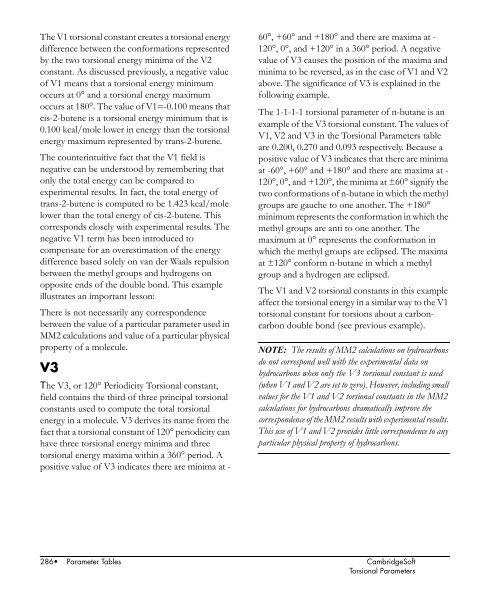Chem3D Users Manual - CambridgeSoft
Chem3D Users Manual - CambridgeSoft
Chem3D Users Manual - CambridgeSoft
You also want an ePaper? Increase the reach of your titles
YUMPU automatically turns print PDFs into web optimized ePapers that Google loves.
Administrator<br />
The V1 torsional constant creates a torsional energy<br />
difference between the conformations represented<br />
by the two torsional energy minima of the V2<br />
constant. As discussed previously, a negative value<br />
of V1 means that a torsional energy minimum<br />
occurs at 0° and a torsional energy maximum<br />
occurs at 180°. The value of V1=-0.100 means that<br />
cis-2-butene is a torsional energy minimum that is<br />
0.100 kcal/mole lower in energy than the torsional<br />
energy maximum represented by trans-2-butene.<br />
The counterintuitive fact that the V1 field is<br />
negative can be understood by remembering that<br />
only the total energy can be compared to<br />
experimental results. In fact, the total energy of<br />
trans-2-butene is computed to be 1.423 kcal/mole<br />
lower than the total energy of cis-2-butene. This<br />
corresponds closely with experimental results. The<br />
negative V1 term has been introduced to<br />
compensate for an overestimation of the energy<br />
difference based solely on van der Waals repulsion<br />
between the methyl groups and hydrogens on<br />
opposite ends of the double bond. This example<br />
illustrates an important lesson:<br />
There is not necessarily any correspondence<br />
between the value of a particular parameter used in<br />
MM2 calculations and value of a particular physical<br />
property of a molecule.<br />
V3<br />
The V3, or 120° Periodicity Torsional constant,<br />
field contains the third of three principal torsional<br />
constants used to compute the total torsional<br />
energy in a molecule. V3 derives its name from the<br />
fact that a torsional constant of 120° periodicity can<br />
have three torsional energy minima and three<br />
torsional energy maxima within a 360° period. A<br />
positive value of V3 indicates there are minima at -<br />
60°, +60° and +180° and there are maxima at -<br />
120°, 0°, and +120° in a 360° period. A negative<br />
value of V3 causes the position of the maxima and<br />
minima to be reversed, as in the case of V1 and V2<br />
above. The significance of V3 is explained in the<br />
following example.<br />
The 1-1-1-1 torsional parameter of n-butane is an<br />
example of the V3 torsional constant. The values of<br />
V1, V2 and V3 in the Torsional Parameters table<br />
are 0.200, 0.270 and 0.093 respectively. Because a<br />
positive value of V3 indicates that there are minima<br />
at -60°, +60° and +180° and there are maxima at -<br />
120°, 0°, and +120°, the minima at ±60° signify the<br />
two conformations of n-butane in which the methyl<br />
groups are gauche to one another. The +180°<br />
minimum represents the conformation in which the<br />
methyl groups are anti to one another. The<br />
maximum at 0° represents the conformation in<br />
which the methyl groups are eclipsed. The maxima<br />
at ±120° conform n-butane in which a methyl<br />
group and a hydrogen are eclipsed.<br />
The V1 and V2 torsional constants in this example<br />
affect the torsional energy in a similar way to the V1<br />
torsional constant for torsions about a carboncarbon<br />
double bond (see previous example).<br />
NOTE: The results of MM2 calculations on hydrocarbons<br />
do not correspond well with the experimental data on<br />
hydrocarbons when only the V3 torsional constant is used<br />
(when V1 and V2 are set to zero). However, including small<br />
values for the V1 and V2 torsional constants in the MM2<br />
calculations for hydrocarbons dramatically improve the<br />
correspondence of the MM2 results with experimental results.<br />
This use of V1 and V2 provides little correspondence to any<br />
particular physical property of hydrocarbons.<br />
286• Parameter Tables <strong>CambridgeSoft</strong><br />
Torsional Parameters











